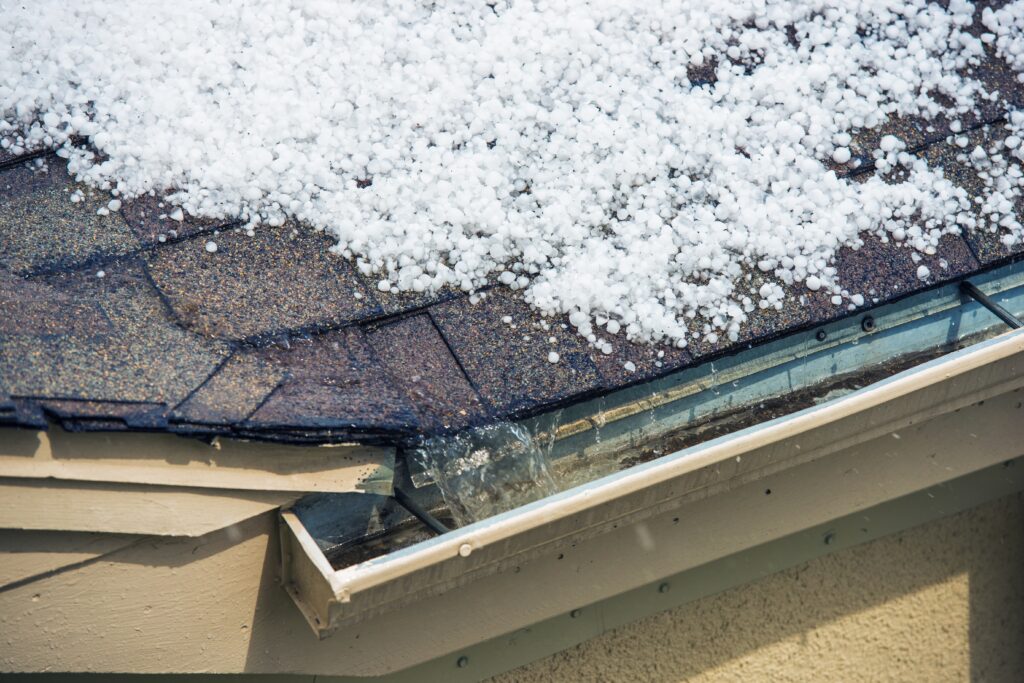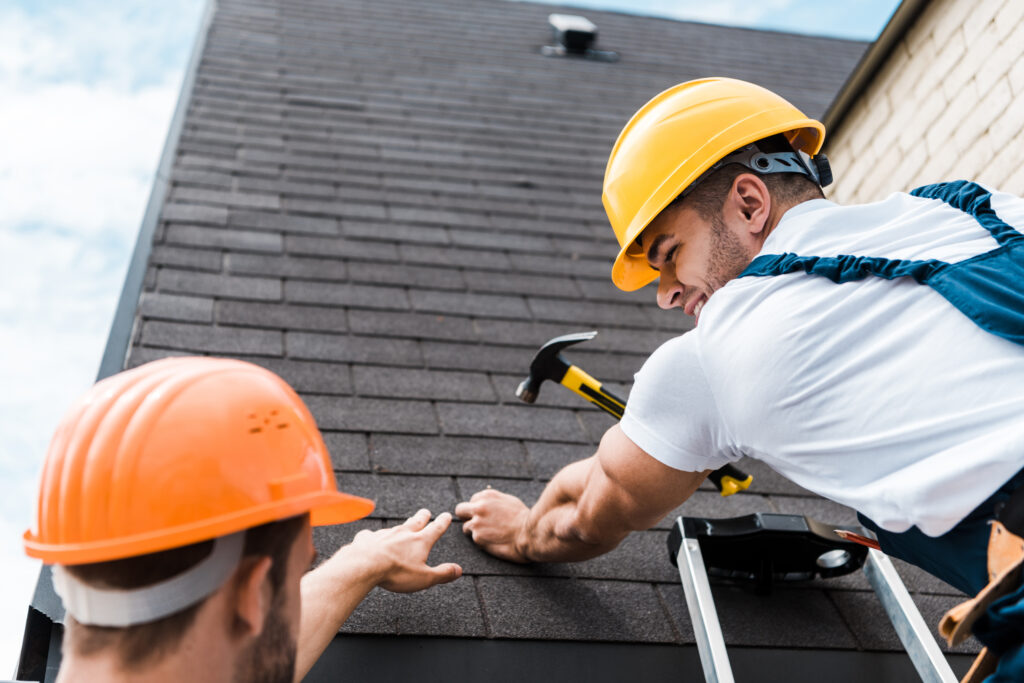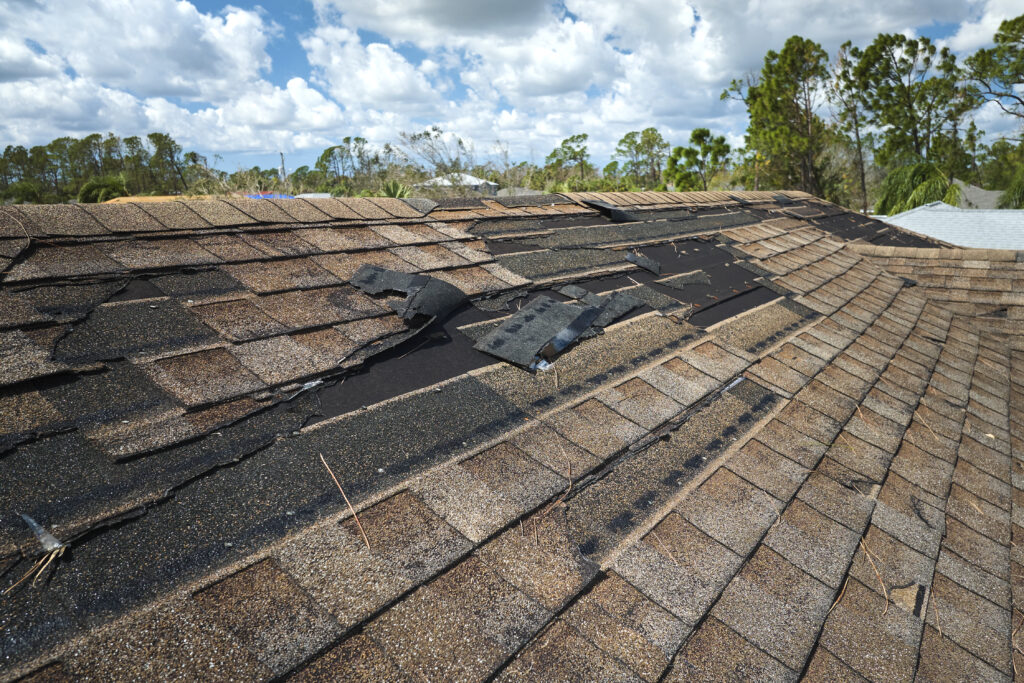Recognizing several types of roof injury is important in sustaining your house’s integrity and worth. From wind and hail to water leaks and structural points, roof injury can stem from varied exterior forces and common put on and tear.
On this article, we’ll information you thru figuring out indicators of roof injury, together with shingle, water, wind, hail, and structural injury. Taking these steps not solely helps in stopping additional injury but in addition ensures your house stays safe and guarded.
Figuring out shingle injury
Figuring out indicators of shingle injury is essential in recognizing injury and preserving the integrity of your roof. Listed here are key indicators and varieties of injury to look out for:
Widespread indicators of shingle injury
- Lacking or broken shingles
- Curling edges on shingles
- Granule loss, indicated by darkish spots or cracks
- Blistered, cracked, or flaking shingles
Hail injury specifics
- Dents or dings on roof vents, gutters, and flashing
- Bruised or dented shingles, which is probably not instantly seen
- Cracked shingles from hail impression
Penalties of ignored shingle injury
- Water leaks and structural injury
- Elevated susceptibility to water leakage
- Potential for water injury inside the home
Shingle injury may result from a wide range of causes, together with storms, hail, and basic put on and tear. It’s necessary to recurrently examine your roof for these indicators of harm to stop additional points. Search for distorted, misplaced, or broken shingles, which may depart your roof weak to water leakage. Moreover, granules discovered at floor stage after heavy rain point out potential roof restore wants. Recognizing these indicators early can prevent from expensive repairs sooner or later.
Recognizing water injury and leaks
Recognizing water injury and leaks early is important in safeguarding your house from potential structural points. Right here’s how one can determine and deal with these issues:
Visible inspection indicators
- Inside: Search for water stains on partitions or ceilings, a typical indication of a roof leak. Broken ceilings might exhibit holes, openings, or indicators of rotting. Within the attic or crawl areas, water stains or dampness sign leaks.
- Exterior: Mildew on exterior partitions suggests extended water intrusion. Recurrently examine these areas, particularly after extreme climate occasions.
Detection instruments and methods
- Make the most of a thermal digicam to pinpoint leaks, both from inside your house or externally utilizing a drone. This superior technique can detect moisture not seen to the bare eye.
- Conduct thorough inspections of the roof from the attic, specializing in areas round current penetrations, as leaks typically happen close to holes or gaps.
Preventative measures {and professional} intervention
- Short-term options, similar to utilizing tarps or waterproof supplies, can reduce injury till skilled repairs are made. Nevertheless, for a long-term resolution, in search of skilled help is essential. Roofing consultants can precisely diagnose the supply of leaks and advocate applicable repairs.
- Common roof inspections, together with checking for broken shingles, open seams, and making certain gutters are away from particles, play an important function in stopping water injury. Change lacking or broken shingles promptly and seal any seen cracks.
Recognizing wind and hail injury
Recognizing wind and hail injury in your roof requires a eager eye and data of what to search for. Listed here are key indicators that can assist you determine potential points:
Wind injury indicators
- Creased shingles: Seen creases can point out shingles have been bent by sturdy winds.
- Displaced shingles: Shingles could also be lifted and resealed or fully blown off, leaving components of the roof uncovered.
- Fastener points: Staples as a substitute of nails might not maintain shingles correctly, main to wreck. A pulled fastener means the shingle gained’t reattach, growing vulnerability.
- Seen injury: Some wind injury, like torn shingles, may be simply noticed from the bottom.

Hail injury indicators
To test for hail injury from the bottom, search for:
- Dings on downspouts
- Injury to storage doorways, window screens, and painted wooden surfaces
- Marks on electrical meters, AC items, grills, mailboxes, and automobiles
Roof leak indicators
- Free step flashing and rusted chimney flashing: These may be precursors to leaks.
- Stains round rest room followers: Usually point out water intrusion.
- Holes drilled on function or a lacking gutter apron: Each can result in water injury.
By understanding these indicators, you possibly can take proactive steps to examine your roof for wind and hail injury. Early detection is vital to stopping minor points from changing into main repairs.
Detecting structural and flashing injury
Detecting structural injury and making certain the integrity of your roof’s flashing are pivotal in sustaining your house’s security and stopping leaks. Right here’s learn how to acknowledge and deal with these points:
Structural injury indicators
- Sagging or uneven roof traces: Usually an indication of moisture buildup, weakening the roof decking and fascia boards.
- Horizontal traces on partitions post-storm: These might point out extra extreme structural injury.
- Damaged gutters or particles accumulation: Factors to improper water drainage, which may exacerbate injury.
Flashing injury indicators
- Seen injury: Search for small holes, rust or corrosion, lacking items, bends, cracks, or dents within the flashing.
- Inner leaks and mould: Staining on fascia boards or mould the place the roof meets exterior partitions can sign flashing failure.
- Worn or broken siding/shingles: Adjoining to the flashing, this will point out potential points.
Preventative measures

- Common inspections: Conduct visible inspections twice yearly, significantly within the fall and spring. For non-flat roofs, contemplate hiring an expert for an intensive evaluation.
- Skilled restore: In the event you detect flashing injury, enlist an expert roofer. Flashing is essential in directing water away from weak areas, put in at each intersection or joint on the roof, together with vent pipes, roof ridges, valleys, dormer partitions, and round skylights.
By staying vigilant and addressing these indicators early, you possibly can forestall bigger, costlier issues down the road, making certain your roof stays a dependable defend in opposition to the weather.
Conclusion
By way of the exploration of varied varieties of roof injury, together with shingle, water, wind, and hail, together with structural and flashing injury, this text has supplied a complete information to figuring out and addressing the various points that owners might face. Recognizing these indicators early is pivotal in stopping additional injury, thus sustaining the structural integrity and worth of your house. Every phase has underscored the significance of vigilant inspections and well timed intervention, emphasizing that data and immediate motion can considerably mitigate potential hazards.
In gentle of the subjects mentioned, it turns into clear that skilled experience is commonly essential to precisely diagnose and successfully restore roof injury. Common inspections and upkeep performed by professionals play a crucial function in prolonging the lifespan of your roof and making certain the protection of your house. For these in search of skilled steerage, don’t hesitate to contact In a position Roof immediately to schedule your free roofing estimate. Addressing roof injury proactively not solely safeguards your house but in addition ensures peace of thoughts for you and your loved ones, additional underscoring the significance of staying knowledgeable and able to act on the indicators of roof injury.

